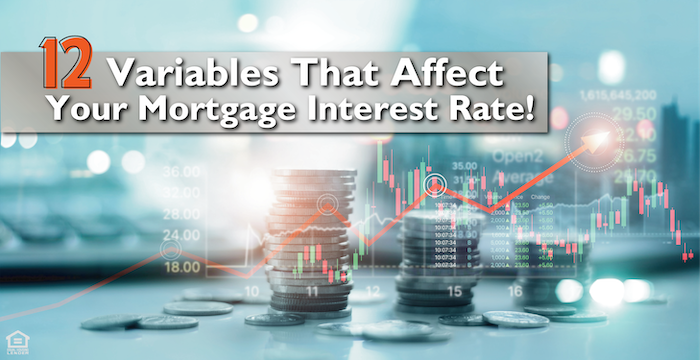12 Variables That Affect Your Mortgage Interest Rate

Every transaction type and borrower’s individual financial profile can influence their borrowing costs. The following variables are used by lenders to determine a borrower’s mortgage interest rate:
1. Property Use
Primary residences typically have the lowest interest rates when compared to second homes and investment properties.
2. Property Type
Single-family homes and condominiums with 25% or more in a down payment or equity have lower interest rates than condos with less than 25% down, multi-family dwellings, and co-ops.
3. Credit Score
In general, borrowers with higher credit scores receive better interest rates than those with lower scores. A borrower with an 800 mid-score might have a rate as much as 1.5% lower than a borrower with a 640 mid-score.
4. Down Payment
In many cases, a larger down payment (30-40%) can lead to a lower interest rate.
5. Discount Points and Origination Fees
Borrowers can pay discount points and origination fees to buy down their interest rate. Loans with discount points are lower than zero-point options.
6. Loan Term
Shorter-term, fixed-rate loans have lower interest rates than longer-term programs. For example, 15-year fixed-rate loans have lower rates than 30-year fixed-rate loans. In certain interest rate markets, Adjustable Rate Mortgages (ARMs) also have lower rates than 30-year fixed-rate loans.
7. Loan Amount
Conforming loan amounts (under $548,251) have the lowest interest rates. These are the average rates that Fannie Mae and Freddie Mac publish weekly. High Balance conforming loans (between $548,251 and $822,375) vary depending on the county the property is located in, and tend to have higher rates than conforming loans. Loans in excess of the Fannie Mae High Balance loan limit are considered jumbo mortgages. Jumbo interest rates can be equal to or higher than the High Balance conforming rates. Even though smaller loan sizes are still considered to be conforming loans, loan amounts under $150,000 can have higher interest rates when compared to a $400,000 loan.
8. Loan Types
Conforming FHA, VA, USDA, and 203K loans all have different interest rates.
9. 1st and 2nd Combo Loans (Piggybacks)
Loans with a concurrent 2nd mortgage can have higher rates than a loan with 20% down or a loan with private mortgage insurance (PMI).
10. Rate Lock Period
Interest rates can be “locked-in” or guaranteed for a period of time to coincide with the closing date. Rate-lock periods can vary from 30 to 60 days. Certain parts of the country close home purchases in under 30 days, where other parts of the country see periods of 60 days or longer from contract to close. Typically, the longer the lock period, the higher the rate or fees. Refinances tend to be locked for 45-60 days, and purchase loan lock periods vary depending on the location of the property.
11. “No Cost” Refinances
There’s no free lunch in America. No-cost refinances have higher rates than refinances where the borrower pays the customary closing costs.
12. Purchase-Money Mortgages, Rate-and Term Refinances, and Cash-Outs
Purchase-money mortgages have lower interest rates than rate-and-term refinances. When borrowers increase their loan amounts or consolidate a first and second mortgage, this is deemed a cash-out refinance. Cash-out rates are usually higher than rate-and-term refinances. All of the above factors influence a borrower’s interest rate. Reliable lenders won’t offer you a one-size-fits-all interest rate when recognizing that everyone’s financial situation is unique.
